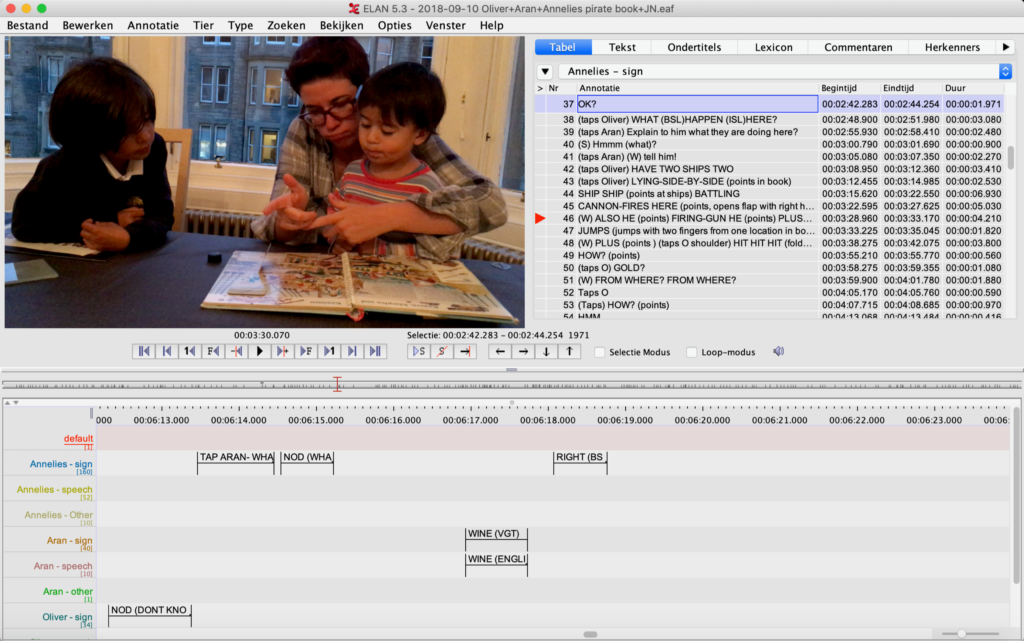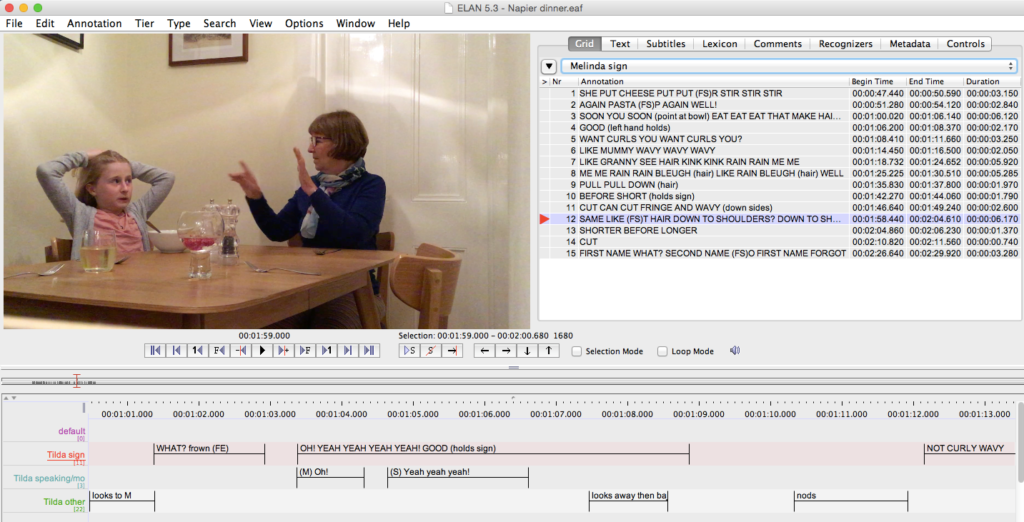By Jemina Napier, Annelies Kusters & Maartje De Meulder
Click here to see this blogpost in International Sign.
We are a team of three mothers and academics (two deaf and one hearing) who sign in our every day lives, including at home. In this project we pool our different academic backgrounds and collective expertise in sign language policy, multilingualism and language brokering (interpreting).
This research project looks at ‘family language policy’ (FLP), more specifically the language practices and language ideologies of bimodal multilingual deaf/hearing families against the backdrop of wider discourses. Previous research on family sign language policy has traditionally focused on hearing parents of deaf children not having prior access to sign language (who are often not fluent signers) and using different methods such as surveys and interviews. Also, previous research has mainly focused on language acquisition of deaf babies and young children.This project is different, focusing on hearing children above 2 years old, who are already bilingual or multilingual and use different signed and spoken languages, and are growing up with a mix of deaf and/or hearing parents and deaf and/or hearing grandparents.

We received funding from the Carnegie Trust for the Universities of Scotland to conduct a pilot study, running from September 2018 till September 2019. The aim is to do this pilot study with a view to leading to a larger study, to explore research methods and themes before final commitment to the research design. We decided to do the pilot study in our own families because in each family, deafness and sign languages are distributed differently as seen in the Figure below (deaf people in grey, hearing in white), and we each use multiple languages and modalities within our mixed deaf-hearing families across different generations.
Family 1: Jemina and her partner and daughter are all hearing, but the four grandparents are deaf. In Family 2: Annelies and her partner are both deaf, her partner’s parents are deaf, and her parents and her two children are hearing. Family 3: Maartje is deaf, her partner is hearing and their children are hearing. All grandparents are also hearing. Family 1 and 2 live in Scotland, UK and Family 3 lives in Flanders, Belgium. Deafness is actually more widely distributed in all three extended families (eg. siblings,aunts, cousins) but since the scope of this study is limited, we choose to focus on children-parents-grandparents units, and we aim to include wider social networks including other family members and friends in a future study.All families use one or more sign languages in the space of the home. In total there are four spoken languages and four sign languages in use: English, Dutch,German, Marathi, British Sign Language (BSL), Indian Sign Language (ISL),Flemish Sign Language (VGT) and International Sign (IS). While the deaf and hearing children and parents in the study are all fluent signers, the grandparents involved in the study have various signing abilities.
Family language policy is intimate and we already have a deep understanding of our family dynamics and contexts. This means we don’t need a long period of immersion first, and are not “strange” researchers coming into families. We are making ethnographic video recordings in our family interactions (see examples below), mostly at mealtimes and at story time, in different contexts such as everyday contexts in the home, or when grandparents visit. In a later stage of the project (April-June 2019) we will include language biographies of the families (and diary extracts on earlier language choice decisions) and interviews to elicit explicit language ideologies (researchers will interview each other, and each other’s relatives).We also will use visual methods such as children’s drawings and language portraits.
While we have the support of three research assistants, each of us is initially annotating their own family interactional data in ELAN annotation software because of the intimacy of FLP and the high context involved (it is often very hard for outsiders to understand signed family communication). One of the researchers’ partners (Annelies’ partner, Sujit Sahasrabudhe) is also involved in annotating data recorded in their own family. The data are checked by two hearing research assistants who annotate when voice is used (normal, loud, or as a whisper) or annotate speech. In the analysis we focus on which languages/modalities are used in which contexts, and on switches between (and combining) languages and language modalities.
We can share a few findings so far based on our preliminary analysis of data:
- FLP is much more complex than using X different signed/spoken languages at home. Real data are “messy”. There are few clean “switches” with person X always using language/modality Y, and the relationship between person X and language/modality Y is not binary.
- One of the other interesting things we have noticed is the relationship between eye gaze and sensory differences and the impact on choice of modality (whether someone chooses to use their voice or not). For example, who they are looking at, whether they are deaf or hearing, and how that influences the way they decide to communicate. It is also striking how much signing is accessed from peripheral vision (eg when telling stories) rather than through direct eye contact.
- We noted how important and frequent touch is in family language communication, more so than is the case in general in sign language communication between deaf and hearing sighted signers. For example, people sign on each other’s body (such as making a sign on a small child’s body or face), touch a small child’s throat (in combination with lip reading) to try to decipher what the child is saying, touch the throat of a hearing child who is singing or humming a song to feel the rhythm. Another example is a mother who’s in conversation with someone when their child asks for attention, holding and rubbing their child’s hand in order to let them know that they are aware the child wants attention and asking them to wait for a bit.
It is clear that we have an extremely rich data set, so we are looking forward to exploring it further. So watch this space,and we will provide a further update further on in the project. But if you would like any further information, please feel free to contact any of us.
*This blog post was first published on Maartje De Meulder’s website on 5th December 2018: https://maartjedemeulder.be/2018/12/05/exploring-family-language-policy-in-deaf-hearing-mixed-families/



